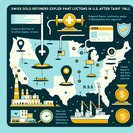
Switzerland and the United States have agreed in principle to slash the punitive 39 % U.S. tariff that has weighed on Swiss exports since August, replacing it with a uniform 15 % ceiling. The breakthrough came late on 14 November after an intense week of negotiations in Washington between Economy Minister Guy Parmelin, State-Secretary Helene Budliger-Artieda, and U.S. Trade Representative Jamieson Greer.
Under the framework, Swiss multinationals—including Roche, Novartis, ABB, and rolling-stock maker Stadler—will channel a combined US$200 billion of fresh capital into U.S. facilities by 2028. Roughly a third of that outlay will arrive in 2026, targeting life-sciences manufacturing clusters in Texas and North Carolina, advanced rail manufacture in Utah, and a new ABB robotics campus in Georgia.
![Switzerland Secures 15 % Tariff Cap in Landmark U.S. Trade Framework, Pledging US$200 B in Investment]()
For global-mobility managers the pact is significant on two fronts. First, the lower tariff removes an existential threat to U.S.–bound supply chains and restores price competitiveness, reigniting intra-company transfers that had been frozen while margins were uncertain. Second, the massive investment pledge will generate thousands of high-skill roles that are likely to be filled partly with Swiss assignees, triggering demand for L-1, E-2 and H-1B visas, as well as Swiss-outbound tax and social-security planning.
The framework still needs to be converted into a full agreement—expected by Q1 2026—but companies are already dusting off mobility budgets. KOF Swiss Economic Institute estimates the tariff cut will lift Swiss GDP growth by at least 0.2 percentage points in 2026, driven mainly by export recovery and assignment-related spending.
Practical take-away: mobility teams should resume scenario planning for 2026-28 U.S. deployments, incorporate the 15 % tariff assumption into cost-projection models, and coordinate early with U.S. immigration counsel to secure talent pipelines before demand spikes.
Under the framework, Swiss multinationals—including Roche, Novartis, ABB, and rolling-stock maker Stadler—will channel a combined US$200 billion of fresh capital into U.S. facilities by 2028. Roughly a third of that outlay will arrive in 2026, targeting life-sciences manufacturing clusters in Texas and North Carolina, advanced rail manufacture in Utah, and a new ABB robotics campus in Georgia.

For global-mobility managers the pact is significant on two fronts. First, the lower tariff removes an existential threat to U.S.–bound supply chains and restores price competitiveness, reigniting intra-company transfers that had been frozen while margins were uncertain. Second, the massive investment pledge will generate thousands of high-skill roles that are likely to be filled partly with Swiss assignees, triggering demand for L-1, E-2 and H-1B visas, as well as Swiss-outbound tax and social-security planning.
The framework still needs to be converted into a full agreement—expected by Q1 2026—but companies are already dusting off mobility budgets. KOF Swiss Economic Institute estimates the tariff cut will lift Swiss GDP growth by at least 0.2 percentage points in 2026, driven mainly by export recovery and assignment-related spending.
Practical take-away: mobility teams should resume scenario planning for 2026-28 U.S. deployments, incorporate the 15 % tariff assumption into cost-projection models, and coordinate early with U.S. immigration counsel to secure talent pipelines before demand spikes.







